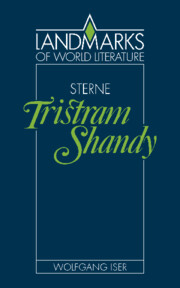III - The play of the text
Published online by Cambridge University Press: 06 January 2010
Summary
The imaginary scene
A mode of writing which refers to itself as it goes along, and a subjectivity that loses itself in its own unfathomableness, together spotlight the limitations of representation, if the latter is understood in accordance with the mimetic tradition of rendering a given. But the inaccessible may also be a given which equally stands in need of presentation. What remains intangible, however, cannot be imitated, but it can be played. For play in the sense of staging is in principle capable of anything. And this is why Tristram regards his narrative not as the reproduction of events, but as a play – and from time to time he reminds his reader of this very fact:
I have dropped the curtain over this scene for a minute, – to remind you of one thing, – and to inform you of another … When these two things are done, – the curtain shall be drawn up again, and my uncle Toby, my father, and Dr Slop shall go on with their discourse, without any more interruption.
(II, 19, 118)Nevertheless, he goes on opening and closing the curtain. As Toby and Walter begin to descend the staircase and pause to carry on the conversation: ‘A sudden impulse comes across me – drop the curtain, Shandy – I drop it – … and hey for a new chapter!’ (IV, 10, 227).
- Type
- Chapter
- Information
- Sterne: Tristram Shandy , pp. 91 - 120Publisher: Cambridge University PressPrint publication year: 1988



